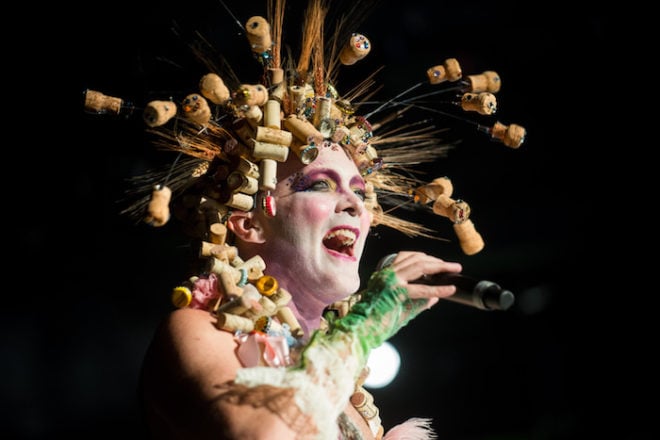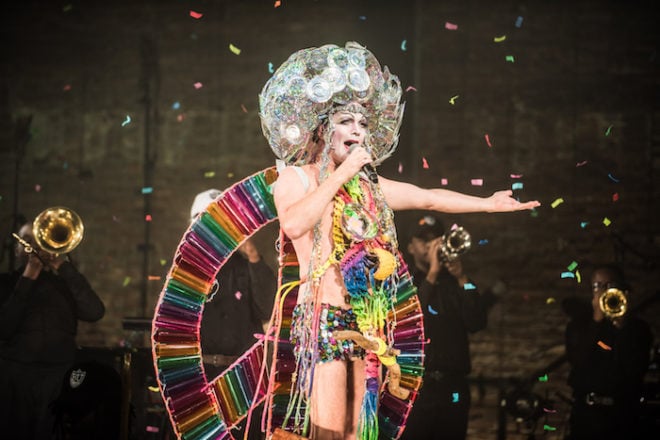Taylor Mac’s “A 24-Decade History of Popular Music” is a theatrical extravaganza in song, talk, and big — really big — costumes that re-envisions queer and underrepresented histories in the United States.
For decades, Mac, an award-winning performance artist, has challenged mainstream ideas about gender and sexuality with shows that spotlight queer identity. This show is perhaps Mac’s most ambitious — A theatrical juggernaut that re-envisions the history of the U.S. through 246 songs that were popular throughout the country, and in its disparate communities, from 1776 to the present.
PERFORMING IN L.A.
The 24-hour tour-de-force — each hour of music represents a decade — will be staged in a four-show series at The Theatre at Ace Hotel in downtown Los Angeles beginning today and split into six-hour chapters stretched over two weeks: chapter two on Saturday, chapter three March 23, and chapter four March 24. The juggernaut show, which is being presented by UCLA’s Center for the Art of Performance.
Mac, the show’s creator-writer-co-director, presented “A 24-Decade History of Popular Music: The 20th Century Abridged” in Los Angeles in March 2016.
Mac, a MacArthur grant recipient who identifies as queer, said, in a statement, that the show “is a reenactment of how the individual(s) may lose the long game, but communities and movements, if continually brought together, have the potential to thrive and bend toward justice.

Taylor Mac’s “A 24-Decade History of Popular Music” is a theatrical extravaganza in song, talk, and big — really big — costumes that re-envisions queer and underrepresented histories in the United States. Photo: Teddy Wolff.
‘REMINDING THE AUDIENCE’
“I’m reminding the audience of the things they’ve forgotten, dismissed or buried — or that others have buried for them,” Mac said. “In this time of obstacle, of political cynicism, amnesia, polarization, oppression and upheaval, we are in desperate need of a physical, emotional, sensorial, and intellectual reminder that we can use the obstacles to strengthen our bonds and communal actions.”
The work won the 2017 Edward M. Kennedy Award for drama inspired by American history and was a 2017 Pulitzer Prize finalist for drama. Also, the show garnered two Bessies for Outstanding Production and Overall Design, an Obie and New York Critics Circle Award for Mac.
Here’s a breakdown of the chapters with descriptions from Mac.
- Chapter I: 1776-1836
The American Revolution; the advent of women’s liberation; and a colonial, heteronormative narrative debunked.
- Chapter II: 1836-1896
The queerest Civil War re-enactment in history and an escape on the Underground Railroad.
- Chapter III: 1896-1956
The War to End all Wars, a speak-easy, a Zoot Suit Riot, and white people flee the cities.
- Chapter IV: 1956-present
Bayard Rustin’s “March on Washington” leads to a queer riot, sexual deviance as revolution, radical lesbians, and a community building itself while under siege.

Taylor Mac’s “A 24-Decade History of Popular Music” is a theatrical extravaganza in song, talk, and big — really big — costumes that re-envisions queer and underrepresented histories in the United States. Photo: Teddy Wolff.
FLAMBOYANT COSTUMES
Costume designer Machine Dazzle, a longtime Mac collaborator, handmade an outrageously flamboyant, world-unto-itself costume specific to each decade. Machine Dazzle won a Henry Hewes Design Award for his work on the show.
Q Voice News caught up with Machine Dazzle, aka Matthew Flower, and talked about his work on Mac’s show and things feathery, glittery, shiny and, yes, dazzling.
Here are some excerpts.
What’s in the name Machine Dazzle
“I earned that name baby cakes,” Machine Dazzle says. “When I moved to New York, in about 1994, I did a lot of clubbing. Someone called me the Dancing Machine, and it stuck. All of my friends called me the Dancing Machine. Then it became the Machine, because the Dancing Machine was a lot of words.
“Then I started doing costumes for a little dance group called the Dazzle dancers, and everyone had a little dazzle name. I just became Machine Dazzle,” he says. “The Dazzle Dancers had their hay-day around 1996, and they’re not dazzling anymore.
His start in costume design
“I was making costumes for myself when I was going out, and I was experimenting with drag. I’m not, like, RuPaul quality. I don’t like boobs. I’m not going for any gender illusion. I keep gender out of it completely. I just love dresses. I love high heels. I love outrageous things, crazy sculptural things. People like what I was doing, and started asking me to do it.
Costumes play a role in the show
“First of all we don’t have elaborate sets and things moving in and out. It’s kind of like one set,” Machine Dazzle says. “The costume at the top of every hour refreshes the stage. The costume serves as the costume, the set, and a prop all at the same time. It’s a 24-hour show, so you’re not going to have one costume. You’re going to have 24 costumes because it’s 24 decades.”
Costumes are art
“Taylor is wearing my art,” Machine Dazzle says. “I consider myself an artist before I am a costume designer. I often say, I’m an artist caught in a costume designer’s mold, because that’s all people know me for. They don’t consider I have other interests, like music. I’m a performance artist in my own right.”
Wardrobe malfunction
“Oh, there was this one really good malfunction. It happened while we were workshopping (“A 24-Decade History of Popular Music”) in San Francisco,” Machine Dazzle says. “One of my favorite costumes, the Crazy Jane costume, has different layers. There’s this big top layer, and it got caught on an under layer, because there’s a lot of fringe. He needed to get on this cherry picker on the stage, and the whole big costume couldn’t fit. The two layers ended up getting stuck together, so we ended up just taking off both costumes, and he was just in his underwear, the headpiece, and the shoes for the rest of that decade.
“I think that was the night Nancy Pelosi and her husband were there. It was so good. It was kind of a fabulous accident, that we actually kept it, and he did every show in his underwear.”
Being gay affects his art
“It absolutely does. I mean, I think it does if you are any kind of alternative person,” Machine Dazzle says. “I lived in very conservative places where it was not OK to be gay growing up. I imagine as a woman, or a person of color, or handicapped, if you’re different and people let you know it, you find alternative ways of thinking. I like to say, I think outside the box, because I was never in the box. They wouldn’t let me in. If you’re a designer it affects your daily life. And if you’re a designer, I guarantee it affects the way you think.”
Fashion lesson for the audience
“The audience has work to do,” Machine Dazzle says. “If you just serve them a beautiful costume, they have no work to do. They just sit and think, Oh, it’s lovely. But if there’s something a little off about it, they’re forced to think about it. I’m not knocking anything that’s camp, beautiful, and gay. That can all be fabulous and lush, and it can be inspiring. But at the end of the day, beautiful falls short if it’s not really interesting. I prefer things that are beautiful and interesting. And I definitely prefer interesting to beautiful.”
